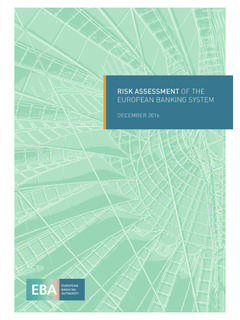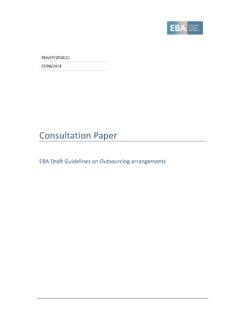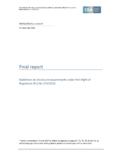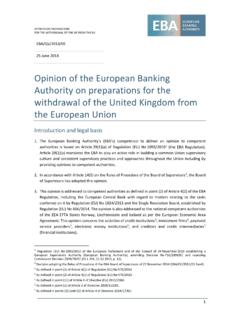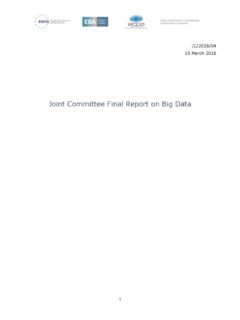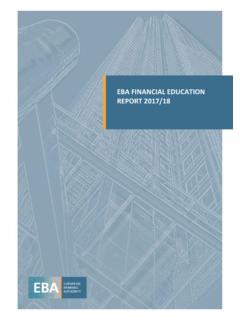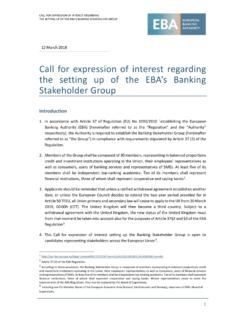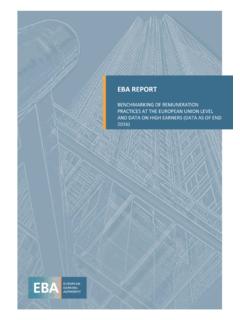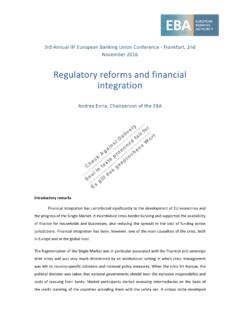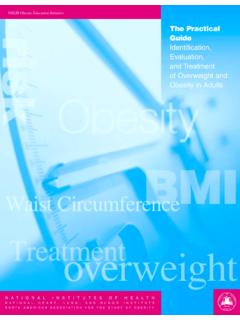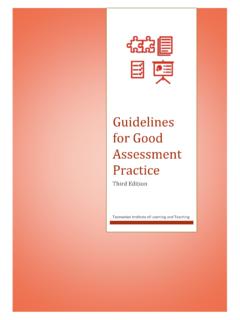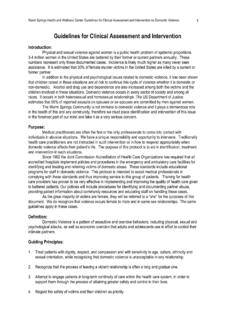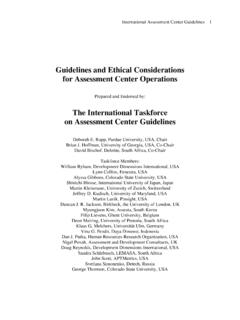Transcription of EBA/GL/2017/12 26 September 2017
1 EBA/GL/ 2017 /12 26 September 2017 Final report Joint ESMA and EBA guidelines on the assessment of the suitability of members of the management body and key function holders under Directive 2013/36/EU and Directive 2014/65/EU FINAL REPORT ON guidelines ON THE assessment OF THE SUITABILITY OF MEMBERS OF THE MANAGEMENT BODY AND KEY FUNCTION HOLDERS 2 guidelines on the assessment of suitability Executive Summary 4 Background and rationale 6 1. Compliance and reporting obligations 16 2. Subject matter, scope and definitions 17 3. Implementation 22 4. guidelines 23 Title I - Application of the proportionality principle 23 Title II Scope of suitability assessments by institutions 24 1. The institutions assessment of the individual suitability of members of the management body 24 2. The institutions assessment of the collective suitability of the management body 26 3.
2 The CRD-institutions assessment of the suitability of key function holders 27 Title III Notions of suitability listed in Article 91(12) of Directive 2013/36/EU 28 4. Sufficient time commitment of a member of the management body 28 5. Calculation of the number of directorships 30 6. Adequate knowledge, skills and experience 32 7. Collective suitability criteria 34 8. Reputation, honesty, and integrity 35 9. Independence of mind and independent members 37 Interaction between independence of mind and the principle of being independent 37 Independence of mind 38 Independent members of a CRD-institution s management body in its supervisory function 39 Title IV Human and financial resources for training of members of the management body 42 10. Setting objectives of induction and training 42 11. Induction and training policy 42 Title V Diversity within the management body 44 12.
3 Diversity policy objectives 44 Title VI Suitability policy and governance arrangements 45 13. Suitability policy 45 14. Suitability policy in a group context 47 15. Nomination committee and its tasks 48 FINAL REPORT ON guidelines ON THE assessment OF THE SUITABILITY OF MEMBERS OF THE MANAGEMENT BODY AND KEY FUNCTION HOLDERS 3 16. Composition of the management body and the appointment and succession of its members 48 Title VII assessment of suitability by institutions 49 17. Common requirements for the assessment of the individual and collective suitability of members of the management body 49 18. assessment of the suitability of individual members of the management body 52 19. assessment of the collective suitability of the management body 53 20. On-g oing monitoring and re- assessment of the individual and collective suitability of the members of the management body 53 21.
4 Suitability assessment of key function holders by CRD-institutions 55 22. Institutions corrective measures 56 Title VIII Suitability assessment by competent authorities 57 23. Competent authorities assessment procedures 57 24. Decision of the competent authority 59 25. Cooperation between competent authorities 61 Annex I Template for a matrix to assess the collective competence of members of the management body 63 Annex II Skills 64 Annex III Documentation requirements for initial appointments 66 5. Accompanying documents 70 Draft cost-benefit analysis / impact assessment 70 Feedback on the public consultation and on the opinion of the Banking Stakeholder Group (BSG) and the Securities and Markets Stakeholders Group (SMSG) 85 Annex A EBA benchmarking regarding the number of directorships, time commitment and training 131 FINAL REPORT ON guidelines ON THE assessment OF THE SUITABILITY OF MEMBERS OF THE MANAGEMENT BODY AND KEY FUNCTION HOLDERS 4 Executive Summary In accordance with the requirements introduced by Directive 2013/36/EU and Directive 2014/65/EU, the European Securities and Markets Authority (ESMA) and the European Banking Authority (EBA) jointly issue guidelines on the notions of suitability, as required by Article 91 (12) of Directive 2013/36/EU and Article 9 (1)
5 Of Directive 2014/65/EU1, and on the assessment of suitability by institutions and competent authorities. The directives aim toremedy weaknesses that were identified during the financial crisis regarding the functioning of the management body and its members. The guidelines aim tofurther improve and harmonise the assessment of suitability within the EU financial sector, and to ensure sound governance arrangements in institutions. The guidelines apply to all institutions, independent of their governance structures (unitary board, dual board or other structures), without advocating or preferring any specific structure as set out in the defined scope of application. The terms management body in its management function and management body in its supervisory function should be interpreted throughout the guidelines in accordance with the applicable law within each Member State.
6 The guidelines specify that all institutions have to assess the members of the management body. Institutions that are subject to Directive 2013/36/EU also have to assess all key function holders that have a significant influence over the direction of the institution under the overall responsibility of the management body. Competent authorities are required to assess all members of the management body. For significant CRD-institutions, competent authorities should assess the heads of internal control functions and the chief financial officer (CFO), where they are not members of the management body. This should be done at the highest level of consolidation, for significant CRD-institutions that are part of a group, but not subject to prudential consolidation by a significant consolidating CRD-institution and at the individual level, if the significant CRD-institution is not part of a group.
7 The guidelines provide common criteria to assess the individual and collective knowledge, skills and experience of members of the management body as well as the good repute, honesty and integrity, and independence of mind. To ensure that members of the management body commit sufficient time to performing their functions, the guidelines set a framework for assessing the time commitment expected of members of the management body and specify how the number of directorships is to be counted. 1 Directive 2014/65/EU enters into application on 3 January 2018 FINAL REPORT ON guidelines ON THE assessment OF THE SUITABILITY OF MEMBERS OF THE MANAGEMENT BODY AND KEY FUNCTION HOLDERS 5 It is important to improve the diversity of management bodies to overcome the risk of group think ; to this end, the guidelines determine how diversity is to be taken into account in the process for selecting members of the management body.
8 Induction and training are key to ensure the initial and ongoing suitability of members of the management body; institutions are therefore required to establish training policies and to provide for appropriate financial and human resources to be devoted to induction and training. Next steps The EBA and the ESMA have published their joint guidelines on the assessment of the suitability of members of the management body which will enter into force on 30 June 2018. The existing EBA guidelines , published on 22 November 2012, will be repealed at the same time. On the same date the EBA guidelines on Internal Governance will come into force. FINAL REPORT ON guidelines ON THE assessment OF THE SUITABILITY OF MEMBERS OF THE MANAGEMENT BODY AND KEY FUNCTION HOLDERS 6 Background and rationale 1. Weaknesses in corporate governance, including inadequate oversight by and challenge from the supervisory function of the management body in a number of credit institutions and investment firms, have contributed to excessive and imprudent risk-taking in the financial sector which has led in turn to the failure of individual institutions and systemic problems.
9 2. Against this background, it has become obvious that the role and responsibilities of management bodies in both their supervisory and management functions should be strengthened in order to ensure sound and prudent management of credit institutions and investment firms, to protect the integrity of the market and the interest of consumers. 3. Directive 2013/36/EU and Directive 2014/65/EU include requirements to remedy weaknesses that were identified during the financial crisis regarding the functioning and composition of the management body and the qualification of its members. 4. The guidelines are intended to apply to all existing board structures and do not advocate any particular guidelines do not interfere with the general allocation of competences in accordance with national company law. Accordingly, they should be applied irrespective of the board structures used (unitary and/or dual board structure and/or other structures) across Member States.
10 The management body, as defined in points (7) and (8) of Article 3(1) of Directive 2013/36/EU, should be understood as having management (executive) and supervisory (non-executive) functions. 5. The terms management body in its management function and management body in its supervisory function are used throughout these guidelines without referring to any specific governance structure and references to the management (executive) or supervisory (non-executive) function should be understood as applying to the bodies or members of the management body responsible for that function in accordance with national law. 6. In Member States where the management body delegates, partially or fully, the executive function to a person or an internal executive body ( chief executive officer (CEO), management team or executive committee), the persons who perform those executive functions on the basis of that delegation should be understood as constituting the management function of the management body.
